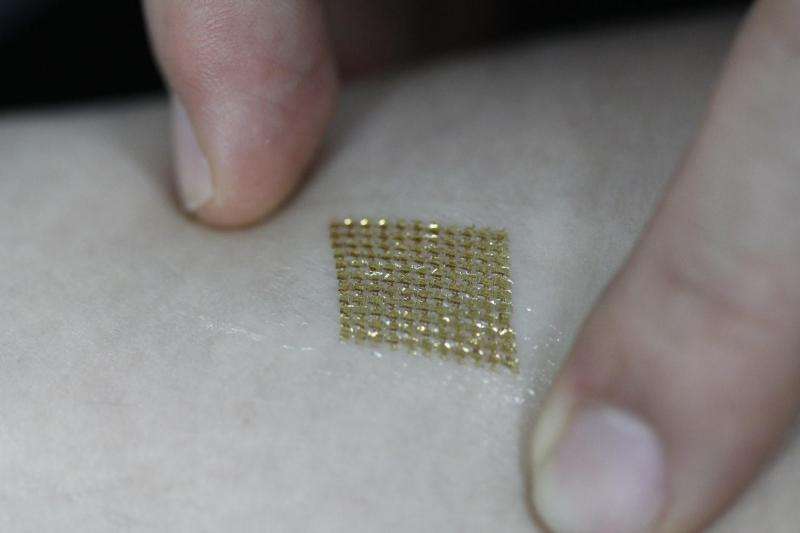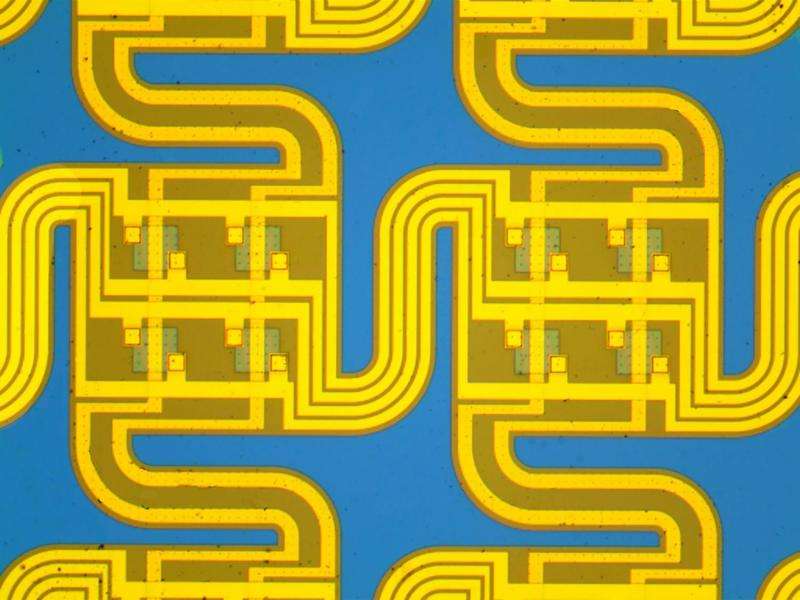A photograph of the wearable, non-volatile memory attached on human skin. Credit: Jaemin Kim
A team of researchers affiliated with several institutions in South Korea has developed a stretchable memory device that can be applied to the skin and used as part of a heart rate monitor. In their paper published in the journal Science Advances, the team describes their memory array and why they believe it is better than the technology that is currently used in bio-sensor wrist bands.
Over the holidays, retailers reported an increase in sales of wrist bands meant to capture bio-data, such as heart rate. But such devices, the researchers contend, suffer from problems with efficiency and stability, because they do not sit close enough to the skin. They have developed a new type of memory array that is can be applied to the skin like patch, and claim that it can withstand stretching associated with skin movement that occurs during the course of everyday life.
The memory array is nonvolatile and made from fully multiplexed silicon and nanocrystal floating gates. The resulting device architecture built by the team is approximately the size of a human thumb and consists of two main parts, an array of ECG electrodes that are used for reading the heart rate, and the memory array—the two are connected together by a bit of electronics that also serve as amplifiers. The result is a patch-like device that is able to be stretched because the membrane material between each of the tiny squares circuits that make up both of the arrays, is flexible.
This video shows the detailed procedures of transferring fabricated device on to human skin. Credit: Jaemin Kim
The team reports that the device also allows for holding more memory than conventional wrist bands, courtesy of closely packed gold nanoparticles, which also provide more chemical stability and longer storage. The device built by the team can record heart rate over an extended period of time. Such a device, the team notes, would be ideal for patients that require continuous and reliable heart rate monitoring as they engage in normal everyday activities. Using the device is a three step process: removing it from a base material using water release tape, transferring in onto a stretchable polymer and then transferring it onto the skin.
This video shows the wearable, non-volatile memory array under a repetitive stretching test and corresponding transfer curves. Credit: Jaemin Kim
A photograph showing memory pixels. Credit: Jaemin Kim
More information: J. Kim et al. A wearable multiplexed silicon nonvolatile memory array using nanocrystal charge confinement, Science Advances (2016). DOI: 10.1126/sciadv.1501101
Abstract
Strategies for efficient charge confinement in nanocrystal floating gates to realize high-performance memory devices have been investigated intensively. However, few studies have reported nanoscale experimental validations of charge confinement in closely packed uniform nanocrystals and related device performance characterization. Furthermore, the system-level integration of the resulting devices with wearable silicon electronics has not yet been realized. We introduce a wearable, fully multiplexed silicon nonvolatile memory array with nanocrystal floating gates. The nanocrystal monolayer is assembled over a large area using the Langmuir-Blodgett method. Efficient particle-level charge confinement is verified with the modified atomic force microscopy technique. Uniform nanocrystal charge traps evidently improve the memory window margin and retention performance. Furthermore, the multiplexing of memory devices in conjunction with the amplification of sensor signals based on ultrathin silicon nanomembrane circuits in stretchable layouts enables wearable healthcare applications such as long-term data storage of monitored heart rates.
Journal information: Science Advances
© 2016 Tech Xplore
























